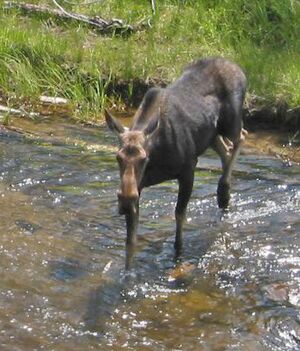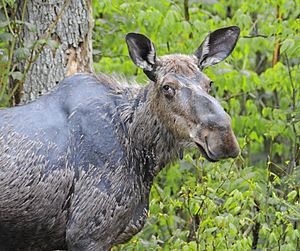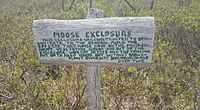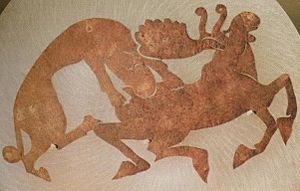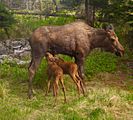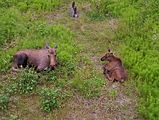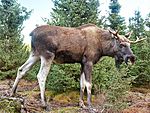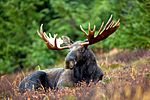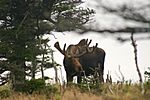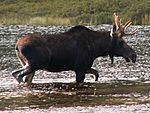Moose facts for kids
Quick facts for kids Moose |
|
|---|---|
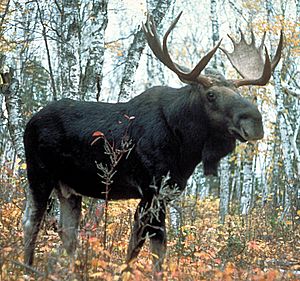 |
|
| Male (bull) | |
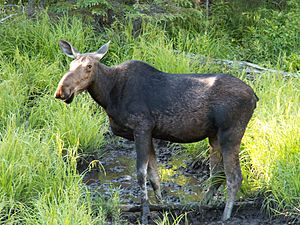 |
|
| Female (cow) | |
| Conservation status | |
| Scientific classification | |
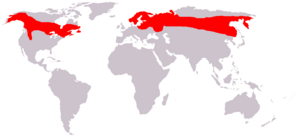 |
|
| Moose range map |
A moose (Alces alces) is the biggest member of the deer family. In Europe, it is sometimes called an "elk." These amazing animals are known for their huge size, unique antlers, and calm behavior. However, it's always best to keep a safe distance from them.
Moose live in northern parts of Europe, Asia, and North America. They often live near lakes, marshes, and swamps. You can also find them in mountain areas.
Contents
What does a moose look like?
Moose have long legs. These legs help them walk through swamps and marshes, which are their favorite places to live. Their long legs also let them reach high branches to eat leaves and twigs. Moose have large, wide hooves. These hooves spread out their weight, stopping them from sinking into soft ground.
They have a thick, shaggy coat that keeps them warm in cold weather. Their fur can be brown to dark brown, sometimes with a grayish color. Moose have very flexible lips, which makes it easy for them to grab plants. They also have a hump on their shoulders. This hump is a strong muscle that helps them hold up their huge antlers.
How big are moose?
An adult moose usually stands about 1.4 to 2.1 meters (4.6 to 6.9 feet) tall at the shoulder. Male moose, called "bulls," typically weigh from 380 to 700 kilograms (840 to 1,540 pounds). Female moose, called "cows," usually weigh 200 to 490 kilograms (440 to 1,080 pounds).
Moose antlers
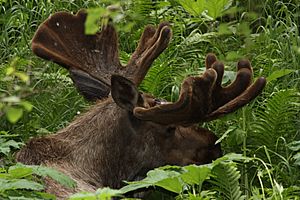
The most amazing part of a bull moose is its antlers. Only male moose grow these huge antlers! They can spread up to 1.8 meters (6 feet) wide and weigh up to 18 kilograms (40 pounds). Moose shed their antlers every year, usually in November or December. New ones then grow back in the spring and summer.
Antlers take about three to five months to grow fully. This makes them one of the fastest-growing animal parts. New antlers are covered in "velvet." This soft, furry skin helps feed the growing bone. The velvet later rubs off as the antlers become hard.
Moose fur
A moose's fur has two layers. The top layer has long, stiff guard hairs. Below that is a soft, woolly undercoat. The guard hairs are hollow and filled with air. This helps keep the moose warm and also helps them float when they swim.
The dewlap
Both male and female moose have a fold of skin under their chin called a dewlap or bell. Scientists are not sure what its exact use is. Some ideas are that it helps in mating, acts as a signal, or shows dominance in males, like antlers do.
What do moose eat?
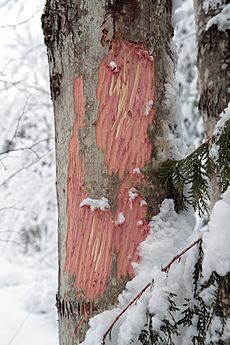


Moose are herbivores, meaning they only eat plants. They eat many kinds of plants, especially non-grasses and fresh shoots from trees like willow and birch.
About half of their diet is usually made up of water plants. Moose need these plants because they give them important sodium (salt). In winter, moose often go to roads to lick salt. This salt is used to melt snow and ice.
Moose do not have upper front teeth. Instead, they have eight sharp teeth on their lower jaw. They also have a tough tongue, lips, and gums. These help them eat woody plants.
Moose are not grazing animals. They are browsers. This means they carefully choose foods that have less fiber and more nutrients. This is similar to how giraffes eat.
Who preys on moose?
A full-grown moose has very few natural enemies. Siberian tigers hunt adult moose. Wolves also pose a danger, especially to female moose with their young calves.
Brown bears are known to hunt moose. However, bears are more likely to take over a wolf's kill or hunt young moose. They usually do not hunt adult moose on their own. American black bears and cougars can catch moose calves. Sometimes, they can even kill adult female moose.
Wolverines mostly eat moose that are already dead. But they have killed moose, even adults, when the moose are weak from harsh winter conditions. Killer whales are the only known ocean predators of moose. They have been seen hunting moose swimming between islands off North America's northwest coast.
Moose social life
Moose are mostly active during the day. They usually live alone. The strongest bonds are between a mother and her calf. Moose rarely gather in groups. However, several moose might be close to each other during mating season.
Moose reproduction and life cycle
Mating season for moose is in September and October. During this time, both male and female moose call out to each other. Males make loud grunting sounds that can be heard from up to 500 meters (1,640 feet) away. Females make sounds that are like wails. Male moose will fight each other for females using their antlers.
Female moose usually give birth to one calf in May or June. If there is a lot of food, they might have twins. Newborn calves have reddish fur, which is different from the brown fur of adult moose. The young moose will stay with their mother until just before her next calves are born.
Moose lifespan
A moose typically lives for about 15 to 25 years in the wild. Many things can affect how long they live. These include being hunted by predators, getting sick, and human activities. Calves are most at risk of dying, with many not surviving their first year. Moose that make it past infancy have a good chance of growing up and living for many years.
Moose and humans
Humans have hunted moose since the Stone Age.
Moose have dark fur, which makes them hard to see when they cross roads at night. Sometimes, they are hit by cars. In countries like Canada, Finland, and Sweden, there are moose warning signs on roads. Motorways often have fences to keep moose off.
Interesting facts about moose
- The moose is the second largest land animal in both North America and Europe. Only the two types of bison are bigger.
- The thickness of a moose's antler beam (the main part of the antler) tells you its age.
- Birds, meat-eating animals, and rodents eat moose's dropped antlers. They are full of protein.
- A typical moose, weighing 360 kilograms (790 pounds), can eat up to 32 kilograms (70 pounds) of food each day.
- Moose are excellent swimmers. Their nose has special pads and muscles that close their nostrils when they are underwater. This stops water from getting in.
- Unlike most farm animals with hooves (ruminants), moose cannot digest hay. Feeding hay to a moose can make it very sick or even kill it.
- The plural form of moose is "moose." You say "one moose" and "many moose."
Moose populations
North America:
- In Canada: There are an estimated 500,000 to 1,000,000 moose. In 2007, about 150,000 moose in Newfoundland came from just four moose introduced in the 1900s.
- In United States: There are estimated to be around 300,000 moose.
- Alaska: In 2011, the state's Department of Fish and Game estimated 200,000 moose.
- Northeast: A wildlife expert estimated 50,000 moose in New York and New England in 2007. This number is expected to grow.
- Rocky Mountain states: Wyoming has the most moose in its 6-state region. In 2009, its Fish and Game Commission estimated 7,692 moose.
- Upper Midwest: Michigan estimated 433 moose in its Upper Peninsula in 2011. Wisconsin had 20–40 moose near its border with Michigan in 2003. Minnesota had 5,600 in its northeast in 2010 and fewer than 100 in its northwest in 2009.
Europe and Asia:
- Finland: In 2009, there was a summer population of 115,000 moose.
- Norway: In 2009, there was a winter population of about 120,000 moose. In 2015, 31,131 moose were hunted. In 1999, a record 39,422 moose were hunted.
- Latvia: In 2015, there were 21,000 moose.
- Estonia: 13,260 moose.
- Poland: 2,800 moose.
- Czech Republic: A maximum of 50 moose.
- Russia: In 2007, there were about 600,000 moose.
- Sweden: The summer population is estimated to be 300,000–400,000. About 100,000 are hunted each fall. About 10,000 are killed in traffic accidents every year.
Moose types (subspecies)
| Eurasian elk | A. a. alces | Found in Finland, Sweden, Norway, Latvia, Estonia, and Russia. No longer in central and western Europe except for Poland, Lithuania, and Belarus. Some are in the Czech Republic, Slovakia, and northern Ukraine. They have been seen in Bohemia since the 1970s and a small group was brought back to Scotland, Great Britain. Recently, they were seen in eastern Germany. (They used to live in France, Switzerland, and Benelux countries.) Their numbers are growing and they are returning to old areas. Males weigh about 320 to 475 kg (705 to 1,047 lb) and females weigh 275 to 375 kg (606 to 827 lb). They stand 1.7 to 2.1 m (5.6 to 6.9 ft) tall at the shoulder. |
| Yakutia moose, or the mid-Siberian/Lena moose | A. a. pfizenmayeri | Lives in Eastern Siberia, Mongolia, and Manchuria. Mostly found in forests of eastern Russia. This is the most common moose in Asia. Its range goes from the Yenisei River in the west and most of Siberia. It does not include the areas of the Chukotka and Amur moose to the east and Northern Mongolia. It is similar in size to the western moose of Canada. |
| Ussurian or Amur moose | A. a. cameloides | Lives from the Amur-Ussuri region of far eastern Russia, and the northeastern part of China. Amur moose are different because their antlers are much smaller, or they might not have any at all. Even adult male antlers are small and deer-like with little flat parts. It is the smallest moose type in Asia and the world. Both males and females stand only 1.65 to 1.85 m (5.4 to 6.1 ft) at the shoulder and weigh between 200 and 350 kg (440 and 770 lb). |
| Chukotka moose or east Siberian moose | A. a. buturlini | Lives in Northeastern Siberia from the Alazeya River basin east to the Kolyma and Anadyr basins. It also lives south through the Koryak range and Kamchatka Peninsula. This is the largest moose in Europe and Asia. It is as big as, or even bigger than, the Alaskan moose (A. a. gigas). This makes it the largest type of deer alive. Males can grow up to 2.15 m (7.1 ft) tall and weigh between 500 and 725 kg (1,100 and 1,600 lb); females are a bit smaller. |
| Eastern moose | A. a. americana | Found in Eastern Canada, including eastern Ontario, all of Quebec, and the Atlantic Provinces. Also in the Northeastern United States, including Maine, New Hampshire, Vermont, Massachusetts, Rhode Island, Connecticut, and northern New York near the Adirondack Mountains. Its population is growing. This is a fairly small type of moose. Females weigh an average of 270 kg (600 lb), males weigh an average of 365 kg (805 lb), and bulls stand up to about 2 m (6.6 ft) at the shoulder. |
| Western moose | A. a. andersoni | Lives from British Columbia to western Ontario, eastern Yukon, Northwest Territories, southwestern Nunavut, Michigan (Upper Peninsula), northern Wisconsin, northern Minnesota, and northeastern North Dakota. This is a mid-sized type. Adult females weigh 340 to 420 kg (750 to 930 lb) and adult males weigh 450 to 500 kg (990 to 1,100 lb) on average. |
| Alaska moose | A. a. gigas | Found in Alaska and western Yukon. This is the largest type of moose in North America. |
| Shiras moose | A. a. shirasi | Lives in Colorado, Idaho, Montana, Oregon, Utah, Washington, and Wyoming. This is the smallest type of moose in North America. It weighs about 230 to 344 kg (510 to 758 lb) when fully grown. |
| † Caucasian moose | A. a. caucasicus | Lived in the Caucasus Mountains. This type is now extinct because of habitat loss and too much hunting. Its range would have included Iran, Russia, Georgia, Azerbaijan, and Turkey. |
Images for kids
-
Skull of a moose
-
A display at the Kenai National Wildlife Refuge. It shows the skulls of two bulls that likely died after their antlers got stuck during a fight.
-
A staged picture of a moose hunt in Norway, date unknown.
-
Moose scat is often found on trails. Some souvenir shops sell bags of it, sealed with shellac and given funny names.
See also
 In Spanish: Alce para niños
In Spanish: Alce para niños



